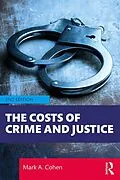This book presents a comprehensive view of the financial and non-financial consequences of criminal behavior, crime prevention, and society's response to crime. Crime costs are far-reaching, including medical costs, lost wages, property damage and pain, suffering, and reduced quality of life for victims and the public at large; police, courts, and prisons; and offenders and their families who may suffer consequences incidental to any punishment they receive for committing crime.
The book provides a comprehensive economic framework and overview of the empirical methodologies used to estimate costs of crime. It provides an assessment of what is known and where the gaps in knowledge are in understanding the costs and consequences of crime. Individual chapters focus on victims, governments, as well as the public at large. Separate chapters detail the various methodologies used to estimate crime costs, while two chapters are devoted to policy analysis - both cost-effectiveness and benefit-cost analysis. The second edition is completely updated and expanded since the first edition in 2005. All cost estimates have also been updated. In addition, due to a significant increase in the number of studies on the cost of crime, new chapters focus on the costs to offenders and their families; white-collar and corporate crime; and the cost of crime estimates around the world.
Understanding the costs of crime can lead to important insights and policy conclusions - both for criminal justice policy and other social ills that compete with crime for government funding. Thus, the target audience for this book includes criminologists and policy makers who are seeking to apply rigorous social science methods to assist in developing appropriate criminal justice policies. Note that the book is non-technical and does not assume the reader is conversant in economics or statistics.
Autorentext
Mark A. Cohen holds the Justin Potter Chair in American Competitive Enterprise at the Owen Graduate School of Management, Vanderbilt University, and also holds a secondary appointment as Professor of Law at Vanderbilt. He was previously a Visiting Professor of Criminal Justice Economics at the University of York, UK, and Chairman of the American Statistical Association's Committee on Law and Justice Statistics. Professor Cohen received his PhD in Economics from Carnegie Mellon University. He is the author of more than 100 books and journal articles on crime, law, and economics.
Inhalt
Contents
List of Tables
List of Figures
List of Boxes
Preface
Acknowledgments
PART ONE - INTRODUCTION
Chapter 1 - Introduction and Overview
- Introduction
- Why Do We Need Estimates of the "Cost of Crime?"
- Relative Harm by Type of Crime
- Aggregate Costs and Benefits
- Benefit-cost Analysis of Crime Control Policies
- History of Cost of Crime Estimates
- Scope of Book and Crime Costs
- Costs Imposed Directly as a Result of Crime
- Cost of Society's Response to Crime
- Offender Costs
- Remainder of Book
- Introduction
- Economic Theory of Crime
- Definition of "Costs"
- External versus Social Costs
- Tangible versus Intangible Costs
- Direct versus Indirect Costs
- Ex Ante versus Ex Post Costs
- Opportunity Costs
- Average versus Marginal Costs
- Cost Reducing Investments
- From Whose Perspective are Costs to be Measured?
- Timing of Costs and Discounting to Present Value
- Methodologies for Estimating Costs
- Tangible Costs of Crime
- Intangible Costs of Crime
- Introduction
- Average Cost of Crime to Victims
- Total Cost of Crime to Victims
- Tangible Victim Costs
- Medical Costs
- Mental Health Care Costs
- Productivity Losses
- Work Days
- Household Services
- School Days
- Property Losses
- Indirect Costs of Victimization
- Intangible Victim Costs
- Pain, Suffering and Reduced Quality of Life
- Lost Quality of Life for Fatal Crimes
- Demographic Breakdown of Costs
- Introduction
- Aggregate Costs of Criminal Justice System
- Criminal Justice and Emergency Response Costs Per Offense
- Police Costs
- Judicial and Legal Costs
- Corrections
- School Security
- Other Emergency Response Costs
- Victim Services
- Victim Restitution and Compensation Programs
- Introduction
- Costs Directly Attributable to Individual Crimes
- Family Members and Other Non-Victims Directly Affected by Victimization
- Lost Productivity to Family Members
- Loss of Services to Family Members
- Psychological Impacts on Family members
- Psychological Impact on Non-Victims and the Public at Large
- Insurance Payments
- Productivity Losses to Employers of Victims
- Public Response to Crime: Crime Prevention and Avoidance Behavior
- Fear of Crime
- Wrongful Convictions
- Introduction
- Costs to Offenders
- Direct Costs of Criminal Activity
- Productivity Losses while Incarcerated
- Risk of Injury, Illness or Death while Incarcerated
- Sexual Assault in Prison
- Premature Death in Prison
- Physical Assault in Prison
- Health Status of Prisoners
- Long-term Costs after Release
- Productivity Losses
- Long-term Health Outcomes
- Increased Risk of Recidivism
- Lost Freedom while Incarcerated
- Costs to Offender Families
- Monetary Costs to Offender Families
- Non-Monetary Costs to Offender Families
- Intergenerational Transmission of Crime
- Costs to Communities and/or Society at Large
- Summing up the Costs of Crime
- Introduction
- Housing Markets and the Cost of Crime <…
Chapter 2 - An Economic Approach to Crime and Costing Methodologies
PART TWO: BOTTOM-UP ESTIMATES OF THE COST OF CRIME AND JUSTICE
Chapter 3 - Victim Costs
Chapter 4 - Public Sector Costs
Chapter 5 - Third-Party Costs
Chapter 6 - Costs to Offenders, Families, and Communities
PART THREE: METHODOLOGIES FOR ESTIMATING THE COST OF CRIME
Chapter 7 - Revealed Preference - Market-Based Approaches
